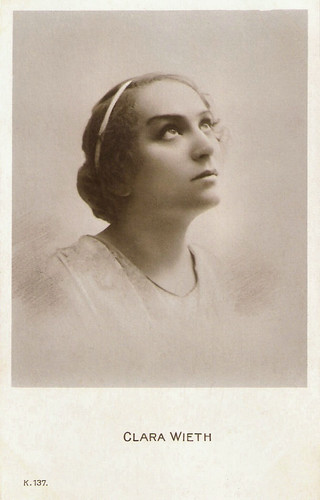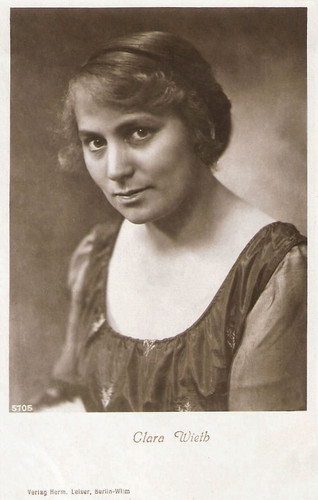
German postcard, no. 5556. Photo: Nordisk.
German postcard by Verleih Hermann Leiser, Berlin, no. 7494.
The White Slave Trade
Clara Wieth was born Clara Rasmussen in Copenhagen, Denmark, in 1883. She was the daughter of merchant H. Rasmussen and his wife Caroline Brammer.
From 1892 on, she attended the Ballet School of Det kongelige Teater (the Royal Theatre) in Copenhagen. Already in 1902, film pioneer Peter Elfelt filmed her there, doing a pas-de-deux. Clara started as a stage actress at Det kongelige Teater in 1901, after which engagements followed at the Dagmar Teatret (from 1905 on), Det Ny Teater (1908-1909)and Alexandra Teatret (1914-1917).
In 1910 she made her film debut. From 1911 on she played in dramas and sensational films, directed by August Blom and produced by Nordisk Film. Her breakthrough was with Den hvide Slavehandels sidste offer/The Last Victim of the White Slave Trade (August Blom, 1911), in which Clara plays an innocent girl who falls in the hand of white slavers who force girls into prostitution. Nordisk Film stated that this film and other White Slave Trade dramas were made to expose the social dangers of white slavery, but audiences enjoyed the sensationalized melodrama and the exploitation of young women placed in compromising positions.
A variation was Mormonens Offer/A Victim of the Mormons (August Blom, 1911), which was controversial for demonizing the Mormon religion. The film's box-office success is cited for initiating a decade of anti-Mormon propaganda films in America. It is the story of an attractive young woman (Clara Wieth) who is seduced and kidnapped by a Mormon missionary, then forced to accompany him to Utah to become one of his wives. The film became a hit, partly due to the popularity of its star, Valdemar Psilander, and partly due to the publicity from The Church of Jesus Christ of Latter-day Saints' objections and its failed campaign to ban the film.
Clara became one the most active and popular actresses of the Danish silent cinema. In Ekspeditricen/Expediency (August Blom, 1911) Wieth was a glove seller who fits a rich man (Carlo Wieth) tight glacé gloves in a gesture which shows the eroticism for which the Danish cinema was famous then. In Ved faengslets Port/Temptations of a Big City (August Blom, 1911) she is the daughter of a usurer who falls in love with a debt ridden playboy (Valdemar Psilander).
As a matter of fact Wieth played several films with her husband Carlo Wieth in the male lead, but also several times opposite Psilander, the most popular Danish actor of the 1910s. Between 1911 and 1913 Clara Wieth was enormously active, playing in over 10 (short) films a year, not only with Blom, such as in Vampyrdanserinden/The Vampire Dancer (August Blom, 1912), but also with other prolific Danish directors like Eduard Schnedler-Sörensen and Holger-Madsen.
Czech postcard by Pressfoto, no. U 401/2 869. Photo: publicity still for Miraklet/The Miracle (Victor Sjöström, 1913).

German postcard by Verlag Hermann Leiser, Berlin-Wilm., no. 5002. Postcard for Laegen/Die Seuche/The Plague (Fritz Magnussen, 1918), with Olaf Fönss.
Leaves From Satan's Book
From 1913 on, Clara Wieth also played in films in Sweden. She worked with the famous Swedish director Victor Sjöström on such films as Miraklet/The Miracle (1913), Bra flicka reder sig själv/A Good Girl Keeps Herself in Good Order (1914), and Prästen/The Clergyman (1914).
She also appeared in films by his compatriot Mauritz Stiller, including Pa livets ödevagar/On the Fateful Roads of Life (1913), and Bröderna/Brothers (1914) with Gunnar Tolnaes.
Among her memorable performances in later years are her roles in the anti-war film Pax aeterna (Holger-Madsen, 1917); Carl Dreyer's Blade af Satans bog/Leaves from Satan's Book (Carl Theodor Dreyer, 1919), the tale of Satan's (Helge Nissen) banishment from heaven; and Häxan/Witchcraft through the Ages (Benjamin Christensen, 1922), in which she played a nun.
Häxan is a study of how superstition and the misunderstanding of diseases and mental illness could lead to the hysteria of the witch-hunts. The film was made as a documentary but contains dramatized sequences that are comparable to horror films. With Benjamin Christensen's meticulous recreation of medieval scenes and the lengthy production period, the film was the most expensive Scandinavian silent film ever made, costing nearly two million Swedish krona. Although it won acclaim in Denmark and Sweden, the film was banned in the United States and heavily censored in other countries for what were considered at that time graphic depictions of torture, nudity, and sexual perversion.
In Dreyer's fairy tale story Der var engang/Once upon a time (Carl Theodor Dreyer, 1922) she plays the female lead of the princess of Illyria in a variation on William Shakespeare's The Taming of the Shrew. Clara Wieth's last role in a silent film was in the Icelandic film Hadda Padda (Guðmundur Kamban, Svend Methling, 1924).

German postcard by Verlag Photochemie, Berlin, no. K. 137.

German postcard by Verlag Hermann Leiser, Berlin-Wilm., no. 5705.
Prima Donna
After her divorce of Carlo Wieth, she worked under the name of Clara Pontoppidan. For years she focused on stage acting, but she returned to the cinema when sound film had set in. In 1932, she appeared in the film Kirke og orgel/Church and Organ (George Schneevoigt, 1932). A year earlier she was awarded the Ingenio et Arti, a Danish medal awarded to prominent Danish and foreign scientists and artists.
In the 1930s, she played some smaller parts in Danish films, directed by Svend Methling. She played leading roles as a prima donna in the stage drama Mens porten var lukket/While the Door Was Locked (Asbjørn Andersen, 1948) and in the romantic comedy Bruden fra Dragstrup/The Bride of Dragstrup (Annelise Reenberg, 1955).
In 1958 she won the Bodil award for best female protagonist as the tragic mother in En kvinde er overflödig/A woman is superfluous (Gabriel Axel, 1957). Her last film performance was in the erotic comedy Takt og tone i himmelsengen/1001 Danish Delights (Sven Methling, 1972).
Clara Wieth was married to actor Carlo Wieth from 1906 until their divorce in 1917. In 1920 she married doctor Pol Vilhelm Pontoppidan and they stayed together until his death in 1953. In 1975, she died in Copenhagen, at the age of 91. Between 1949 and 1963 Wieth had published her memoirs in four parts.
German postcard by Photochemie, Berlin, no. K. 1513. Photo: Nordisk Film.
Scene from Ved Fængslets Port/Temptations of a Big City (August Blom, 1911). Source Radio Santos (REM - YouTube).
Trailer for Häxan/Witchcraft through the Ages (Benjamin Christensen, 1922). Source: Todo El Terror Del Mundo (YouTube).
Sources: Danskefilm (Danish), Wikipedia and IMDb.
No comments:
Post a Comment